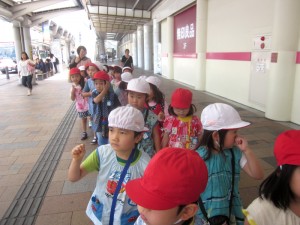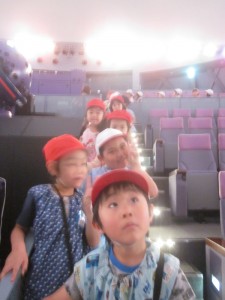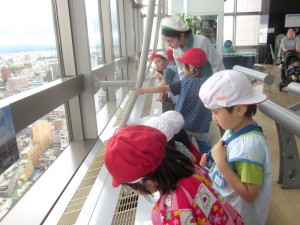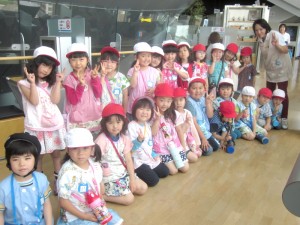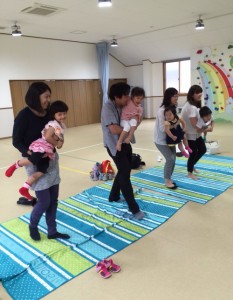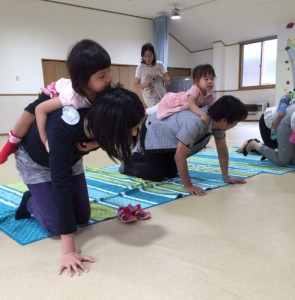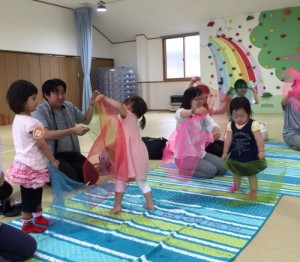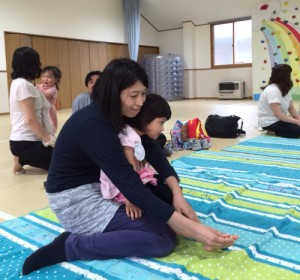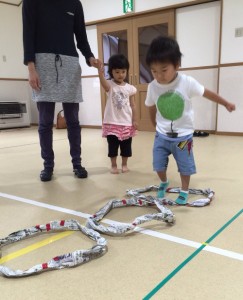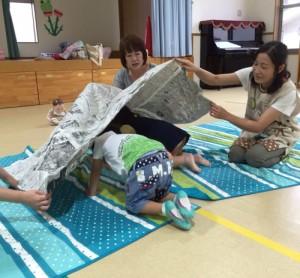More than five years have passed since the earthquake and tsunami devastated much of eastern Japan in March 2011. Looking back on the past half-decade, we are sharing some stories and recollections from those we have been “walking together” with since the devastation, one by one.
Given below is a story from the eighth speaker in this series, Ms. Yoshiko Maeshiro from the Okinawa Diocese, who is the principal of St. Matthew’s Kindergarten, Okinawa. She has visited St. Paul’s Kindergarten, Koriyama, Fukushima, to help, as part of the “One3 Family” program of assistance to Fukushima. Also, she warmly welcomed families from Fukushima as a host family in a summer program called “Home Stays Okinawa.” Yoshiko is a friend of Fukushima people, who carefully observes what is happening there.
“One Family — in Union”
Ms. Yoshiko Maeshiro, Okinawa Diocese
The English below written and arranged by Heeday, based on the original Japanese
The English edited by Rev. Dr. Henry French, ELCA
The East Japan Earthquake of 2011, in addition to the tsunami, caused the indescribable calamity of the Fukushima Daiichi meltdown. Thinking of those affected in Fukushima, all I could do was pray for them. I was especially worried about the kindergartens of Fukushima, imagining what it would be like if the same thing happened to my kindergarten. Still, worrying was all I was able to do.
Anyone can see how terrible a natural disaster can be. Now, the meltdown and the resulting spread of radioactive substances are threatening lives. I listened to priests and others who had visited Fukushima and I learned that the children there were (and still are) experiencing many restrictions as they played outdoors. The hardships those kindergartens were experiencing were discussed in news reports from the “Zen Nihon Shiritsu Yochien Rengo Kai” (All Japan Association of Private Kindergartens), which made me worry about all those children and their instructors who have been affected.
In July 2014, the Okinawa Diocese asked the kindergartens of “Sei Ko Kai Hoiku Renmei” (Anglican Nursing Association) to send some instructors to the “One Family” program. As a result, I visited St. Paul’s Kindergarten, Koriyama, Fukushima, three times.
First visit (October 2014)
Another instructor, named Nanako, went to Koriyama first. Though I was nervous at first, the children and instructors welcomed us warmly and soon we felt at home. We spent very meaningful time every day. Right after reporting to work, we wiped out the floors of the kindergarten to remove radioactive substances. This cleanup covered the second floor hall as well, and Nanako and I worked hard on it every morning. Well, in our kindergarten, cleaning up the kindergarten floors is something we have to do every day, yet here the purpose is drastically different. We had to remove radioactive substances that had crept in between the window panes and sills. Doing this every morning, before taking care of the children, was indeed a lot of work.
The instructors there were quite brisk at their work and very efficient. They communicated well among themselves and this affected their children favorably. The kids were also quite honest, and shouted “yippee” every time a go-ahead was given for them to play outdoors. There, they were “ordinary” children. Also, they had learned many ways to play indoors and knew how to cope with the realities of contamination.
On my first day, I took a taxi from the railroad station to St. Paul’s. On the way, I was enchanted by lovely streets and parks, clad with beautiful trees that are nonexistent in Okinawa. Still, I heard later on, that residents there were (and are) unable to walk around without a Geiger counter. Indeed, I saw many bags of collected radioactive soil piled up in front of houses. The people are not living in a clean environment. So, all those parks and trees look empty….
I had talks with the kindergarten’s mothers as well, and most of them had decided to remain in Koriyama, Fukushima, in spite of their worries about radiation. Their cheerfulness and determination gave me encouragement.
Second visit (June 2015)
Two months after Japan’s new school year (which begins in April) began, the children I knew were now in new grades and welcomed me cheerfully. Many of them recognized me, and I was soon at home with them. Mainly, I took care of the class of two-year-old kids. The kids of St. Paul’s were very cheerful and full of spirit. They were quick in saying “thank you.” Nice kids to work with. This time, they installed a vinyl pool in the kindergarten’s yard and the kids bathed in it on days with lower radioactivity. I honestly wished they could bathe as they wanted to every day.
Every time we visited the kindergarten, we suggested that instructors and parents there should “come to Okinawa for a retreat.” After this visit was over, I had a call saying that a family named the Kamei hoped to visit Okinawa. So, in August, the family and I met again at my St. Matthew’s Kindergarten. Though we did not spend time together all the way, they did seem to be having a great time. I was so happy that finally some people from Fukushima had a retreat here in Okinawa. The family still sends me e-mails, once in a while.
Third visit (October 2015)
This time, I visited St. Paul’s with another instructor, named Minako. Though the children were not able to run around outdoors, St. Paul’s instructors were united in taking good care of every single child, providing the right instruction whenever necessary. Their “get to the purpose” attitude impressed me. I had to wonder whether I had a clear purpose to help St. Paul’s when I visited it. Until this visit, my attitude was closer to “I hope I won’t disturb them.” This time, however, I made up my mind to really “help”.
St. Paul’s instructors were quite friendly and they were very disciplined in their behavior and speech. They certainly inspired me to work in the same way. On my last day at St. Paul’s, we had an outing to a park called Kamegashiro. Before we hit the road and before we prayed, St. Paul’s principal, Atsuko, said to the children, “We can go on this outing thanks to the help of many people. Remember to be thankful to them all. We are not alone. In the park, have fun, play, and build up your body so that you can help others someday.”
Over the last five plus years, numerous volunteers have visited Koriyama to help the kindergarten cleanup radioactive substances and hold parties to cheer up both the children and the instructors. The principal, I suppose, was filled with gratitude to them all and expressed her gratitude to the children in the words quoted above. Soon after the 2011 disaster, St. Paul’s resumed its nursing after tremendous effort. I appreciate all the hard work of its staffers and kids. I sure hope they will all remain in good health, with the same vigor.

